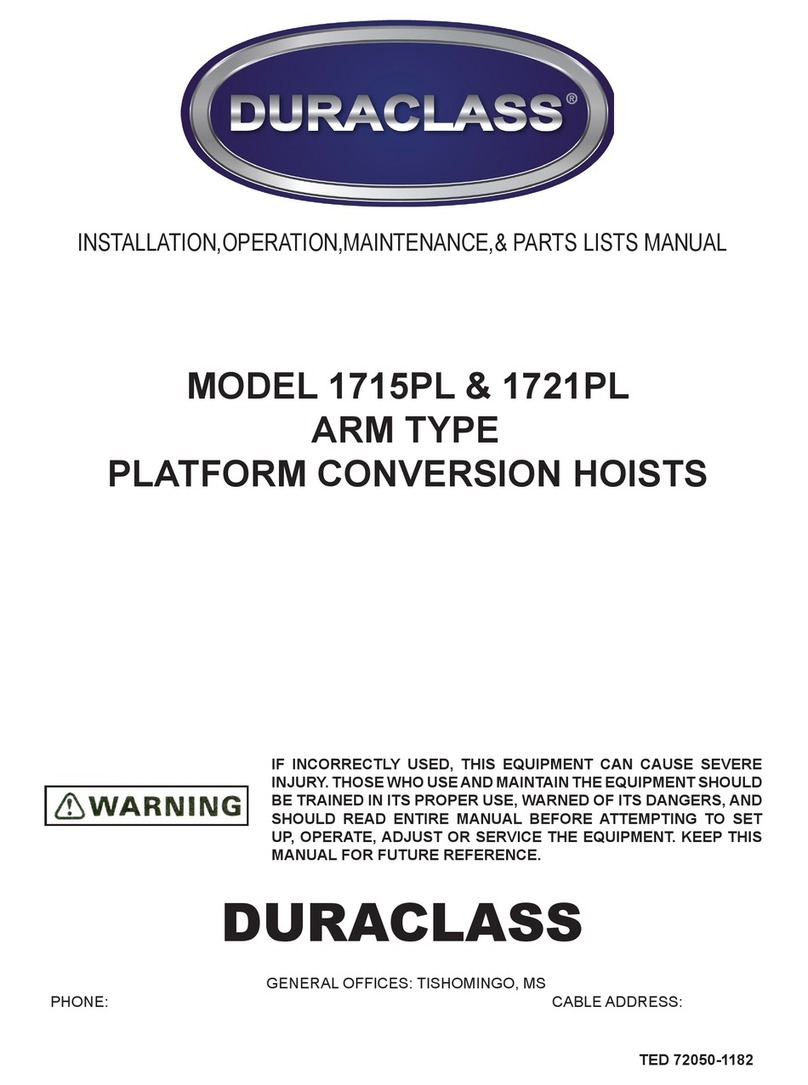
IMPORTANT SAFETY NOTICE
Proper service and repair are important to the safe, reliable operation of the DURACLASS
products. Service procedures recommended by DURACLASS are described in this service
manual and are effective for performing service operations. Some of these service operations
may require the use of tools or blocking devices specialty designed for the purpose. Special
tools should be used when and as recommended. It is important to note that some warnings
against the use of specic methods that can damage the product or render it unsafe are stated
in the service manual. It is as important to understand these warnings are not exhaustive.
DURACLASS could not possibly know, evaluate and advise the service trade of all conse-
quence of each way. Consequently, DURACLASS has not undertaken any such broad evalua-
tions. Accordingly, anyone who uses service procedures or tools which are not recommended
by DURACLASS must rst satisfy himself thoroughly that neither his safely nor the products
safety will be jeopardized by the method he selects.
"DURACLASS as manufacturer of the equipment that is covered by this manual, is providing
a product to the user who has acknowledged to have superior knowledge of the conditions
of the use to which the product will be put DURACLASS relies upon the user's superior
knowledge in specifying any changes or modications including but not limited to the inclu-
sion or non inclusion of options that are required by the user and the DURACLASS product,
and for the particular application of the user relative to the DURACLASS product."
WARRANTY
DURACLASS warrants this unit to be free from defects in material and workmanship, under normal
use and service, for a period of 1 year, said period to run from the date when rst placed into opera-
tion.
This warranty is expressedly limited to the replacement or repair at such place as DURACLASS may
designate, of such parts of such products as shall be returned to it with transportation charges prepaid
(all collect shipments will be refused) and which shall appear to its satisfaction, upon inspection at
such place designated by it, to have defective in material or workmanship. In lieu of such repair or
replacement. DURACLASS may elect to issue a credit or refund for such products.
This warranty does not apply to any unit of DURACLASS equipment which shall have been repaired
or altered outside of the DURACLASS so as to affect its stability or which has been subject to mis-
use, negligence or accident or which shall have been installed or operated other than in accordance
with the printed instructions of DURACLASS.
This warranty does not obligate DURACLASS to bear the cost of labor in replacing defective parts.
No other obligation is assumed or authorized to be assumed with respect to products of DURA-
CLASS other than herein set forth.
DURACLASS DOES NOT ASSUME ANY LIABILITY FOR SECONDARY CHARGES, EX-
PENSES FOR ERECTING OR DISCONNECTING, OR ANY OTHER CONSEQUENTIAL LOSS-
ES OR DAMAGES.
"WE MAKE NO OTHER WARRANTY, EXPRESS OR IMPLIED, AND MAKE NO WARRANTY
OF MERCHANTABILITY OF FITNESS FOR ANY PARTICULAR PURPOSE."
"NO EMPLOYEE CAN CHANGE THIS WARRANTY, UNLESS APPROVED IN WRITING BY
THE GENERAL SALES MANAGER OR THE PRODUCT MANAGER."
DURACLASS




























